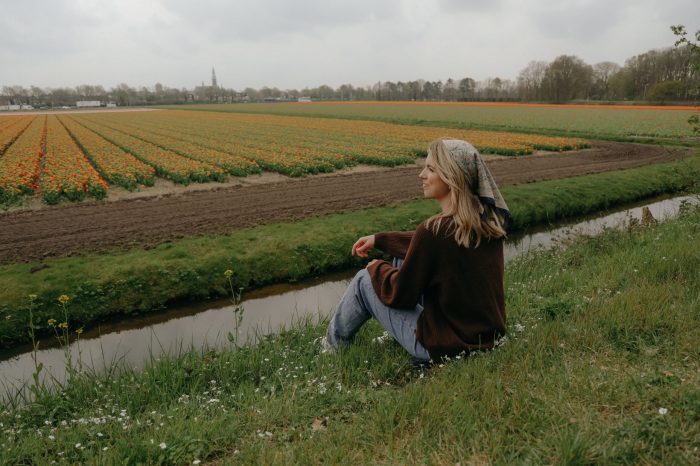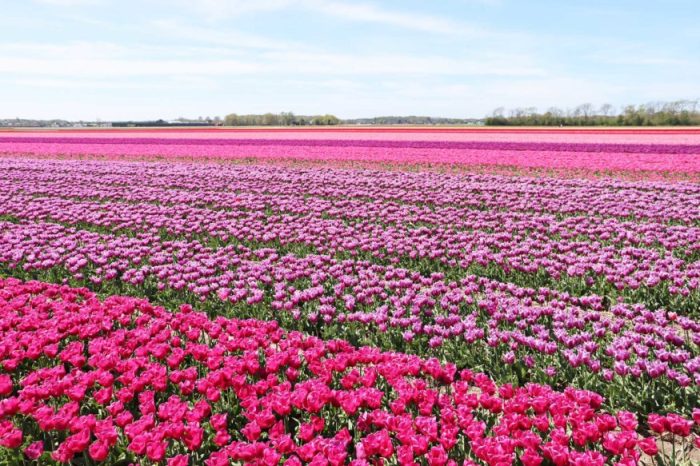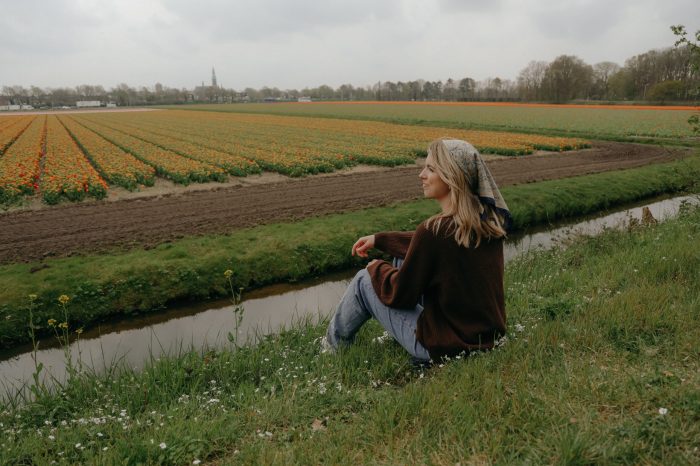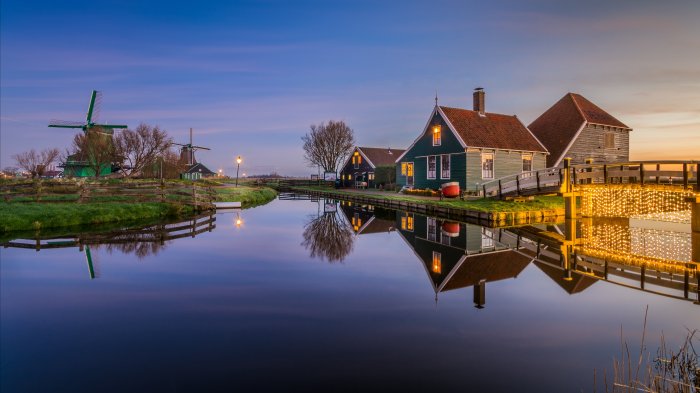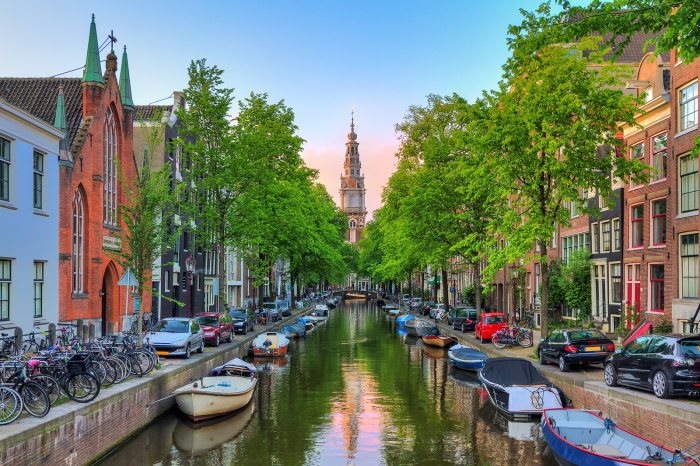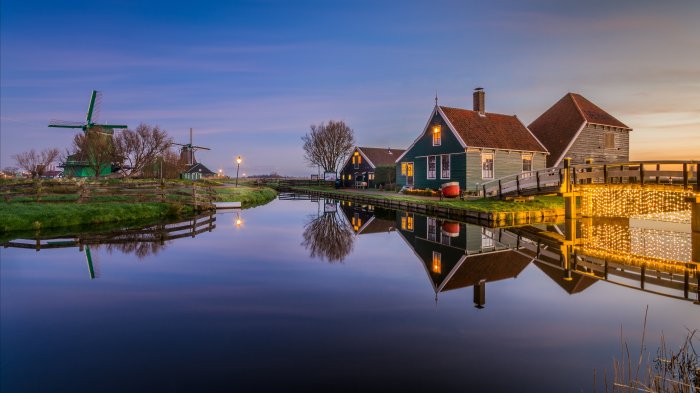Best places to visit in the Netherlands: From bustling Amsterdam to charming historic villages, the Netherlands offers a captivating blend of urban excitement and rural tranquility. This guide explores the must-see destinations, highlighting the unique experiences awaiting travelers. Delve into the vibrant canals of Amsterdam, the picturesque windmills of Zaanse Schans, and the rich history of other captivating regions.
Discover the hidden gems and bustling cityscapes that await your exploration.
This comprehensive guide unveils the best spots for your Dutch adventure, providing insights into the diverse regions and experiences to ensure you craft a memorable journey. Whether you’re seeking cultural immersion, historical exploration, or simply a relaxing getaway, the Netherlands promises a unique travel experience.
Introduction to the Netherlands
The Netherlands, a land of vibrant cities, picturesque canals, and stunning landscapes, captivates tourists with its unique blend of history, culture, and modern amenities. From the iconic windmills of Zaanse Schans to the artistic heart of Amsterdam, the country offers a diverse range of experiences. Its rich history, marked by trade, innovation, and resilience, is interwoven with its modern appeal, creating a destination that’s both charming and dynamic.
The country’s low-lying nature and impressive engineering feats are testaments to its ingenuity, further enhancing its allure.The Netherlands’ history as a trading nation has significantly shaped its cultural identity and its appeal to travelers. The Dutch Golden Age, a period of immense artistic and scientific flourishing, left an indelible mark on the country’s cultural heritage, evident in its museums, galleries, and architectural marvels.
This history, combined with the country’s contemporary cultural scene, offers a compelling narrative for visitors. This journey through time and the present makes the Netherlands a truly captivating destination.
Regions of the Netherlands
The Netherlands is comprised of various regions, each with its unique characteristics and attractions. The country’s diverse landscapes and historical sites contribute to its appeal as a tourist destination. From the bustling cityscapes to the serene countryside, there’s something for everyone.
Key Destinations
The Netherlands boasts a wealth of captivating destinations. The following table highlights a few key locations, categorized by type and briefly describing their appeal.
| Destination | Type | Description |
|---|---|---|
| Amsterdam | City | A vibrant city with canals, museums, and nightlife. Known for its iconic architecture, historical significance, and cultural scene, Amsterdam is a must-see for any visitor. |
| Zaanse Schans | Historic Village | A charming village with windmills and traditional crafts. It offers a glimpse into the Netherlands’ rich past, showcasing historical buildings, windmills, and working demonstrations of traditional Dutch crafts. |
| Keukenhof Gardens | Gardens | Famous for its stunning spring displays. Millions of tulips, daffodils, and other flowers bloom annually, transforming the gardens into a breathtaking spectacle. |
| Rotterdam | City | A modern metropolis with impressive architecture and a vibrant atmosphere. Rotterdam is known for its iconic skyline and urban design, contrasting with the historical charm of other Dutch cities. |
Example Activities
A wide array of activities are available to visitors in the Netherlands. Exploring museums, indulging in local cuisine, and experiencing the scenic countryside are all part of the Dutch experience. These experiences provide a holistic understanding of the nation’s history, culture, and natural beauty.
Amsterdam
Amsterdam, the vibrant heart of the Netherlands, pulsates with a unique blend of history, culture, and modern life. From its picturesque canals to its world-renowned museums, the city offers a captivating experience for every visitor. The city’s rich past is interwoven with its present, creating a tapestry of experiences that are both inspiring and unforgettable.The city’s canal system, a UNESCO World Heritage site, is a defining characteristic.
These waterways, lined with charming houses and bridges, offer a unique perspective on the city’s beauty. Amsterdam is a city that invites exploration, encouraging visitors to wander its streets and discover its hidden gems.
Top 5 Must-See Attractions
Amsterdam boasts a wealth of iconic attractions. These sites, steeped in history and artistic significance, provide a glimpse into the city’s soul.
- Anne Frank House: A poignant reminder of the Holocaust, the Anne Frank House offers a deeply moving experience. Visitors are able to step into the hidden annex where Anne Frank and her family hid from the Nazis during World War II. The house provides a powerful perspective on resilience and the human spirit.
- Rijksmuseum: Housed in a stunning building, the Rijksmuseum showcases a remarkable collection of Dutch Masters, from Rembrandt to Vermeer. The museum’s impressive collection is a testament to the Netherlands’ rich artistic heritage.
- Van Gogh Museum: Dedicated entirely to the life and works of Vincent van Gogh, this museum provides a comprehensive understanding of the artist’s artistic development. The museum offers insight into the personal struggles and creative genius that shaped van Gogh’s iconic works.
- Canal Cruise: A leisurely canal cruise offers a unique perspective on Amsterdam’s architectural beauty. These scenic journeys provide a memorable way to appreciate the city’s canals and the houses lining them. It is a relaxing way to soak in the atmosphere.
- Begijnhof: A tranquil courtyard, the Begijnhof is a hidden gem in the heart of Amsterdam. This peaceful oasis offers a glimpse into the city’s history and its quieter moments. Its serene atmosphere is a welcome contrast to the bustling city streets.
Best Neighborhoods to Explore
Amsterdam’s diverse neighborhoods offer distinct experiences for tourists. Each area showcases a unique personality, reflecting the city’s multifaceted nature.
- Jordaan: Known for its charming streets, independent boutiques, and cozy cafes, the Jordaan neighborhood offers a glimpse into Amsterdam’s bohemian side. The area is perfect for strolling, browsing unique shops, and enjoying a delicious meal.
- De Pijp: A vibrant neighborhood with a multicultural atmosphere, De Pijp is known for its lively cafes, restaurants, and street markets. It’s a great spot to experience Amsterdam’s cosmopolitan spirit.
- Nine Streets: Famous for its picturesque canal-side houses and historic atmosphere, the Nine Streets area offers a charming experience for tourists seeking a taste of Amsterdam’s rich history. The architecture is a wonderful example of traditional Dutch design.
- Red Light District: While sometimes controversial, the Red Light District is a unique and important part of Amsterdam’s history. It offers a glimpse into the city’s cultural landscape and its historical role in trade and commerce.
Transportation Options
Amsterdam offers various transportation options for tourists. These options ensure easy and efficient travel throughout the city.
- Public Transportation: Amsterdam’s extensive public transportation network, including trams, buses, and metro lines, connects all major parts of the city. This makes navigating the city convenient and affordable for tourists.
- Cycling: Amsterdam is renowned for its extensive network of bike paths. Cycling is a popular and convenient way to explore the city, allowing visitors to experience its charm at their own pace.
- Walking: Walking is a great way to explore the city’s charming streets, squares, and canals. This allows visitors to discover hidden gems and soak in the atmosphere.
Museum Comparison, Best places to visit in the netherlands
A table comparing different museums in Amsterdam based on their focus and appeal.
The Netherlands boasts stunning canals and picturesque windmills, but if you’re looking for a taste of local brews, you’ll want to check out the best craft breweries in Brisbane. Exploring the charming Dutch countryside and enjoying a fantastic selection of locally crafted beers in Brisbane, like those found at best craft breweries brisbane , makes for a truly memorable experience.
Ultimately, the Netherlands offers a captivating blend of history and modern charm, making it a perfect destination for any traveler.
| Museum | Focus | Appeal |
|---|---|---|
| Rijksmuseum | Dutch Masters | History and art |
| Van Gogh Museum | Van Gogh | Art and personal life |
| Stedelijk Museum Amsterdam | Modern and contemporary art | Innovative art |
| Heineken Experience | History of Heineken | Brewery and beer lovers |
Beyond Amsterdam
The Netherlands offers far more than just the vibrant canals and iconic architecture of Amsterdam. Beyond the city’s allure lie diverse regions, each with its own unique character and attractions, waiting to be explored. From the picturesque countryside to the stunning coastline, and bustling cities, the Netherlands has something for every traveler.
Exploring the Picturesque Countryside
The Dutch countryside is a feast for the senses, a harmonious blend of rolling hills, charming villages, and picturesque landscapes. Experiencing the Dutch countryside is about more than just sightseeing; it’s about immersing yourself in the local culture and traditions. The beauty of the countryside is found in the small details: the quaint windmills, the traditional farmhouses, and the serene meadows.
- Zaanse Schans: This charming village is a living museum, showcasing traditional Dutch windmills, working farms, and picturesque houses. Visitors can witness the craftsmanship of local artisans and experience the essence of Dutch rural life.
- Kinderdijk Windmills: A UNESCO World Heritage Site, this iconic windmills complex offers a glimpse into the ingenuity and resilience of Dutch people. The sight of these historical structures, meticulously preserved, against the backdrop of the Dutch landscape, is truly unforgettable. Visitors can take a boat tour, or walk along the paths, appreciating the serene beauty of the surroundings.
Coastal Delights
The Dutch coast offers a stark contrast to the countryside, with stunning beaches, charming seaside towns, and the thrill of the North Sea. The coast is ideal for relaxation, water sports, and exploring the maritime history of the Netherlands.
- Texel: This largest of the Dutch North Sea Islands, is a paradise for nature lovers. Visitors can explore the vast dunes, enjoy the breathtaking coastal views, and discover the unique flora and fauna. The island is perfect for cycling tours, beach walks, and wildlife spotting.
- Scheveningen: A bustling seaside resort town, known for its long sandy beaches, vibrant atmosphere, and exciting amusement park. Visitors can soak up the sun, play in the sand, enjoy the sea breeze, and partake in various activities like water sports and amusement park rides.
Charming City Escapes
The Netherlands boasts numerous charming cities beyond Amsterdam, each with its own unique allure. These cities often offer a slower pace of life, a chance to immerse yourself in the local culture, and discover hidden gems.
Exploring the charming canals of Amsterdam or the picturesque windmills of Kinderdijk are just a couple of highlights when planning a trip to the Netherlands. However, if you’re looking for a unique experience, consider a Taylor Swift-themed cruise in Miami – a truly unforgettable journey! This exciting cruise, complete with themed decorations and music, might be the perfect break from exploring the stunning Dutch landscapes, before you return to discover the best of the Netherlands.
taylor swift themed cruise miami offers a fun diversion before you delve deeper into the beautiful Dutch countryside. The Netherlands has so much to offer, beyond the picturesque scenery, which is why it remains one of my favorite places to visit.
- The Hague: The political heart of the Netherlands, The Hague is a city rich in history and culture. Visitors can explore the beautiful palaces, museums, and the iconic Peace Palace. It offers a blend of political history, art, and culture.
- Utrecht: This historic city, situated along the Lek River, is known for its charming canals, cozy cafes, and picturesque bridges. Utrecht’s medieval architecture, vibrant atmosphere, and vibrant nightlife are some of the reasons it is a popular destination.
Regional Atmospheres
| Region | Atmosphere | Activities |
|---|---|---|
| Zaanse Schans | Historic, quaint | Windmills, cheese demonstrations |
| The Hague | Political, cultural | Museums, palaces, peace palace |
| Texel | Natural, serene | Cycling, beach walks, wildlife spotting |
| Scheveningen | Bustling, seaside | Beaches, amusement park, water sports |
| Utrecht | Charming, historic | Canals, cafes, bridges |
Activities and Experiences
The Netherlands offers a diverse range of activities, from exploring iconic windmills to indulging in delicious cuisine. Whether you’re a history buff, an outdoor enthusiast, or a foodie, there’s something for everyone. This section details a variety of experiences, considering optimal times to visit and accommodation options, ensuring a memorable trip.The Netherlands, with its rich history and picturesque landscapes, provides an unforgettable experience for visitors.
This section will delve into the specifics of activities and experiences, considering factors like weather and crowd size to help you plan your perfect trip.
Exploring the Dutch Countryside
The Dutch countryside boasts stunning landscapes, perfect for outdoor enthusiasts. Exploring the tulip fields during springtime is a breathtaking experience, with vibrant colors filling the fields. The best time to visit is during the peak bloom, typically in April and May, although other times offer unique charm. The quieter months of June to September provide opportunities for hiking and cycling in the Dutch countryside without the crowds.
Consider staying in charming farm stays or cozy guesthouses for a truly immersive experience. These offer a unique insight into rural Dutch life, often with facilities like bicycles and gardens for guests.
Canal Cruises and City Tours
Canal cruises offer a unique perspective of Amsterdam’s historic canals and picturesque houses. These tours often provide insights into the city’s rich history and architecture. Amsterdam’s canal system is best experienced during the spring and fall months, when the weather is pleasant and the crowds are more manageable. Summer brings larger crowds, but also more vibrant atmosphere.
For a more intimate experience, consider a private canal cruise. These often offer a more personalized experience and are less crowded. Alternatively, consider a guided walking tour to explore the city’s hidden gems and learn about its culture.
Traditional Dutch Dinner
A traditional Dutch dinner is a great way to experience the local cuisine. Dishes like herring, stroopwafels, and Dutch cheeses are essential components of a Dutch culinary experience. These dishes are available in numerous restaurants throughout the country. The Dutch food scene is diverse and caters to all tastes and budgets, ranging from affordable local eateries to upscale restaurants offering Michelin-starred experiences.
Consider dining in a traditional “brown café” for an authentic experience. These establishments often feature traditional Dutch cuisine and have a cozy, local atmosphere. They’re great for a taste of local life and offer unique culinary experiences.
Accommodation Options
The Netherlands offers a variety of accommodation options to suit different budgets and preferences. Hotels range from budget-friendly options to luxury accommodations. For a more immersive experience, consider staying in a cozy guesthouse or a charming bed and breakfast. These often provide a more personal touch and a glimpse into local life. Alternatively, renting an apartment or a house provides more space and flexibility.
This can be particularly useful for families or groups. Consider the location of your accommodation, as this can greatly affect your travel time and experiences. For example, staying in the city center provides easy access to attractions, while accommodations outside the city center can offer more affordable options. Ultimately, the best accommodation choice depends on individual preferences and the type of experience desired.
Planning Your Trip
Embarking on a Dutch adventure requires careful planning. Understanding the nuances of budgeting, necessary documents, and efficient transportation will significantly enhance your trip. This section provides a structured approach to ensure your journey is seamless and enjoyable.
Budgeting for Your Trip
Creating a realistic budget is crucial for a satisfying Dutch experience. Accommodation costs, food expenses, transportation, and activities all contribute to the overall cost. Consider the varying price ranges for different types of accommodations, from budget-friendly hostels to luxurious hotels. Eating out in Amsterdam can be more expensive than in smaller towns, so factor this into your daily food budget.
Activities like museum visits and boat tours have varying costs, and pre-booking can sometimes offer better deals. A rough estimate of €50-€100 per day for a moderate traveler, adjusting based on your preferences, is a helpful starting point.
Essential Travel Documents and Regulations
Knowing the necessary travel documents and regulations for entering the Netherlands is essential. Citizens of many countries can enter the Netherlands visa-free for short stays. Ensure your passport is valid for at least three months beyond your intended stay. Check the official Dutch government website for the most up-to-date information on visa requirements. Additionally, verify the specific requirements for your nationality and any applicable travel insurance policies.
The Netherlands boasts stunning canals and picturesque villages, perfect for a relaxing getaway. But to truly maximize your trip, consider investing in some top-notch personalized luggage. For example, exploring the best personalized luggage brands can make packing for your Dutch adventures easier and more stylish best personalized luggage brands. This will help you carry your memories home in style, ready to plan your next trip to the amazing tulip fields and windmills!
Getting Around the Netherlands
The Netherlands offers various transportation options to navigate its diverse landscapes. Trains are a convenient and efficient way to travel between major cities, with high-speed connections available for longer distances. For shorter trips and exploring within cities, trams, buses, and metro systems are readily available and affordable. Cycling is a popular and iconic way to experience the Dutch countryside and urban areas.
Consider renting a bike for a day or longer to explore at your own pace. Public transportation is generally well-connected and affordable. If traveling to remote areas or villages, consider the feasibility of a car, but be prepared for potential parking challenges in urban areas.
Booking Accommodations and Tours
Booking accommodations and tours in advance is highly recommended, especially during peak season. Online platforms like Booking.com, Expedia, and Airbnb provide a wide selection of options. When choosing accommodation, consider factors like location, amenities, and price. For tours, consider reputable tour operators like GVB, Holland.com, or Viator, to ensure a high-quality experience. Comparing prices and reading reviews will help you make informed decisions.
Many museums and attractions also offer pre-booked tickets, which can save you time and potentially money. Booking in advance guarantees availability, especially during busy periods.
Food and Drink

The Netherlands boasts a surprisingly diverse culinary landscape, blending traditional recipes with global influences. From hearty stews to innovative modern dishes, the food scene reflects the country’s rich history and multicultural society. Beyond the famous stroopwafels, a treasure trove of local specialties and unique dining experiences awaits the adventurous eater. The Dutch also have a deep-rooted appreciation for quality ingredients and a sophisticated understanding of pairing food with drink.Dutch cuisine, while often perceived as simple, is characterized by fresh, seasonal produce and a focus on comforting flavours.
The emphasis on local ingredients creates a harmonious blend of taste and sustainability, while innovative chefs are pushing boundaries and elevating the dining experience. This section will delve into the best of Dutch culinary delights, from iconic dishes to hidden gems, along with an exploration of their unique drinks and coffee culture.
Famous Dutch Cuisine and Local Specialties
Dutch cuisine is often characterized by its practicality and simplicity, focusing on hearty dishes and readily available ingredients. Savory stews like “hutspot” (a potato and vegetable stew) and “bitterballen” (deep-fried meatballs) are staples, demonstrating a preference for comforting and substantial meals. Furthermore, the Dutch have a deep appreciation for fresh seafood, particularly herring, often served in various styles.
Regional variations add depth and nuance to the overall culinary experience.
Best Places to Eat in Different Cities and Regions
Exploring the Dutch culinary scene is best approached by visiting different cities and regions. Amsterdam, with its vibrant culinary scene, offers a plethora of choices, ranging from traditional Dutch cafes to internationally acclaimed restaurants. In the cozy city of Utrecht, one can find unique culinary experiences focused on local produce and artisanal products. The province of Friesland, known for its dairy farms, offers a range of culinary experiences, showcasing the region’s fresh cheeses and traditional dishes.
Furthermore, the coastal regions are known for their fresh seafood, providing a taste of the North Sea.
Unique Drinks Available in the Netherlands
The Netherlands is known for its brewing traditions, offering a wide variety of beers, from light lagers to strong stouts. Furthermore, the Dutch appreciate their coffee, with cafes playing a significant role in social life. Local ciders and fruit juices add to the range of non-alcoholic beverages. Beyond these, a significant aspect of Dutch hospitality involves enjoying strong, robust coffee and tea, which is often paired with pastries and snacks.
Dutch Coffee Culture and its History
The Dutch have a rich history with coffee, dating back to the 17th century, when the Dutch East India Company introduced coffee to Europe. Initially, coffee houses served as social hubs, providing a space for discussions and the exchange of ideas. Today, the Dutch coffee culture emphasizes quality ingredients and preparation methods, resulting in a robust and flavourful experience.
The Dutch appreciation for quality coffee has extended to a wider range of beverages, such as tea, where the Dutch are also known for high-quality teas.
Accommodation Options

Finding the perfect place to stay is crucial for a memorable Dutch adventure. From charming boutique hotels to budget-friendly hostels, the Netherlands offers a wide array of accommodation options to suit every traveler’s needs and preferences. Understanding the different types and considering factors like budget, location, and amenities will help you make the best choice for your trip.Choosing accommodation involves more than just price.
Location significantly impacts your experience, whether you’re exploring the vibrant city life of Amsterdam or the picturesque landscapes of the countryside. Amenities like breakfast, Wi-Fi, or parking can also be important considerations, especially if you’re traveling with family or need specific facilities.
Types of Accommodation
The Netherlands caters to a diverse range of travelers with various accommodation choices. From luxurious hotels to cozy guesthouses and budget-friendly hostels, you’ll find options to match your needs and budget. Hotels provide a standard level of comfort, while hostels offer a social atmosphere for budget-conscious travelers. Consider also guesthouses and bed and breakfasts, often offering a more personal and local experience.
Factors to Consider When Choosing
Several factors are important when selecting accommodation. Your budget is a primary consideration, as prices vary significantly between different types of lodging. Location is equally crucial, influencing your ease of access to attractions, restaurants, and transportation. Amenities like Wi-Fi, breakfast, or parking are also worth considering, depending on your travel style and needs.
Budget Considerations
Budget is a critical element in accommodation selection. Hotels, especially in popular destinations like Amsterdam, can be expensive. Hostels and guesthouses are more budget-friendly, offering shared rooms and communal spaces. Consider your travel companions and the length of your stay when deciding on your budget. For example, a family of four may prefer a larger apartment rental or a hotel with interconnecting rooms to keep costs down.
Location Considerations
The location of your accommodation significantly impacts your experience. Staying in the heart of Amsterdam, for example, offers easy access to museums, canals, and nightlife. However, it will likely come at a higher price. Alternatively, choosing accommodation slightly outside the city center might provide better value for money while still allowing you to explore the city easily via public transportation.
Amenities Considerations
Amenities like breakfast, Wi-Fi, and parking should be considered during your selection process. If you need reliable Wi-Fi for work or personal use, ensure the accommodation provides it. Breakfast can save you time and money, and parking is important if you’re traveling by car.
Comparing and Booking Accommodation Online
Several websites provide a comprehensive platform for comparing and booking accommodations online. Sites like Booking.com, Expedia, and Airbnb offer extensive listings, allowing you to compare prices, read reviews, and book accommodations directly. Using these sites, you can filter results by budget, location, amenities, and type of accommodation to find the perfect match. Reading reviews from previous guests is a valuable tool in evaluating the quality and suitability of a particular accommodation.
For example, if you need a quiet environment, look for reviews highlighting the hotel’s peacefulness.
Examples of Well-Rated Accommodations
Numerous well-rated accommodations are available in various cities and regions of the Netherlands. In Amsterdam, the Hotel Pulitzer and the Conservatorium Hotel are frequently praised for their location and amenities. For a more budget-friendly option, consider the Generator Amsterdam. In the countryside, the De Vlinderhoeve and the Landgoed de Hoge Veluwe are highly regarded for their unique atmosphere and proximity to nature.
These are just a few examples; researching specific locations and needs will help you discover more.
Getting Around
The Netherlands boasts an excellent network of transportation options, making it easy to explore its diverse landscapes and vibrant cities. From bustling Amsterdam to picturesque windmills in the countryside, navigating the country is a breeze for tourists, with choices ranging from efficient trains to leisurely bike rides. Understanding the various modes and their pros and cons is key to planning your trip effectively.
Transportation Options
The Netherlands offers a multifaceted approach to getting around, catering to different needs and preferences. Trains provide a speedy and convenient way to travel between major cities, while buses offer more affordable options for reaching smaller towns and villages. Cycling is an iconic part of Dutch culture, offering a unique perspective of the country and a healthy way to see the sights.
Train Travel
Trains are a popular choice for longer distances, connecting major cities like Amsterdam, Rotterdam, and Utrecht efficiently. High-speed trains can significantly reduce travel time between these destinations. Ticket prices vary depending on the distance, class of service, and booking time. Booking in advance often results in more affordable fares. For example, a trip from Amsterdam to Rotterdam by train can take as little as 30 minutes on a direct high-speed train, offering a quick and comfortable journey.
Bus Travel
Buses provide a more budget-friendly alternative to trains for shorter distances and connecting to smaller towns. They often offer more frequent departures, making them ideal for travelers on a tighter budget. However, travel times may be slightly longer compared to trains. A bus route from a major city to a nearby village often offers a more affordable and potentially more scenic way to explore.
Cycling
Cycling is deeply ingrained in Dutch culture, and it’s an excellent way to experience the country at a relaxed pace. The Netherlands has a vast network of dedicated cycle paths, making it safe and enjoyable for all skill levels. Renting a bicycle is readily available in most cities, offering a practical way to explore neighborhoods and local areas.
For instance, a cycling trip through the countryside can reveal charming villages and picturesque landscapes, offering a unique and memorable experience.
Public Transportation Combination
Combining different modes of transportation is a practical approach for reaching destinations that aren’t directly connected by a single mode. For instance, a train to a nearby city, followed by a bus or bike ride, could be the most efficient way to reach a specific location. Careful planning and route checking can maximize efficiency and minimize travel time.
Using Public Transportation Effectively
Navigating the Dutch public transportation system is straightforward. Purchase a travel pass for multiple journeys or individual tickets, depending on your travel needs. Use online platforms or the local transportation app to check schedules and routes, ensuring you are well-prepared for your journey. Using real-time information about departures and arrivals can also be helpful to avoid delays.
For example, the “9292” app provides real-time information and can guide you effectively in navigating the public transport system in the Netherlands.
Best Routes
The best route for getting from one destination to another depends on the specific locations and your preferences. Utilize online mapping tools to find the most suitable route considering travel time, cost, and the mode of transportation you prefer. For example, a trip from Amsterdam to The Hague often involves a direct train route, making it an easy and efficient option.
Images and Visuals
The Netherlands boasts a captivating visual tapestry, from the vibrant hues of its flower fields to the striking architecture of its cities. Its beauty lies not just in individual landmarks, but in the harmonious blend of nature and human creation that shapes the overall visual experience. Understanding the visual appeal of different regions and activities provides a deeper appreciation for the country’s unique charm.Dutch artistry extends beyond its famous windmills and canals to encompass the everyday, reflecting in its landscapes, buildings, and even its cuisine.
The visual narrative of the Netherlands invites exploration, promising a feast for the eyes.
Picturesque Landscapes
Dutch landscapes are renowned for their serene beauty, often characterized by a harmonious blend of water and land. The Dutch countryside is dotted with vibrant flower fields, particularly during the spring season. Imagine fields of tulips, daffodils, and hyacinths in full bloom, creating a breathtaking tapestry of color. These fields, often framed by picturesque waterways, provide a captivating visual experience.
Beyond the flowers, the Dutch countryside offers rolling hills, expansive meadows, and the characteristic Dutch polders, showcasing the ingenuity of human intervention with nature. These polders, reclaimed from the sea, present a unique visual narrative of man’s mastery over the elements, juxtaposed against the natural beauty of the surrounding water.
Iconic Buildings and Architecture
The Netherlands is a treasure trove of architectural styles, from the historic grandeur of Amsterdam’s canals to the modern marvels found in Rotterdam. Amsterdam’s canal houses, with their distinctive gabled roofs and colorful facades, offer a charming visual narrative. The iconic buildings of Zaanse Schans, with their traditional Dutch windmills, offer a captivating glimpse into the country’s rich past.
The futuristic architecture of Rotterdam, particularly the Cube Houses, represents a stark contrast, highlighting the country’s ability to embrace both tradition and modernity. These contrasting architectural styles showcase the country’s dynamic and diverse visual heritage.
Visual Appeal of Activities
The visual appeal of Dutch activities extends beyond the picturesque landscapes. Consider the unique experience of cycling through the Dutch countryside. Imagine the vibrant colors of the tulips juxtaposed against the backdrop of the Dutch countryside, as you glide through the idyllic scenery. The serene beauty of a canal cruise, with the iconic houses lining the waterways, offers a different visual experience.
These experiences capture the essence of Dutch life, offering a visual narrative that is both captivating and unforgettable.
Visual Elements of Dutch Cuisine
Dutch cuisine, while sometimes understated, offers a visual appeal that is unique and engaging. The fresh produce, often featured prominently in Dutch dishes, provides a visually appealing element. The vibrant colors of seasonal vegetables, like carrots, beets, and leafy greens, create a delightful visual presentation. The simple, yet elegant presentation of dishes, often showcasing fresh ingredients in a visually pleasing manner, reflects a mindful approach to culinary artistry.
This attention to visual detail elevates the dining experience, adding to the overall enjoyment of Dutch cuisine.
Outcome Summary: Best Places To Visit In The Netherlands
In conclusion, the Netherlands, with its rich history, vibrant cities, and stunning landscapes, provides an unparalleled travel experience. From the iconic canals of Amsterdam to the picturesque windmills of Zaanse Schans, and the diverse experiences across its regions, the Netherlands offers a journey that captivates the senses. This guide has offered a glimpse into the many wonders this captivating nation holds, inspiring you to plan your own unforgettable Dutch adventure.
Remember to plan meticulously and embrace the unique charm of each location.

